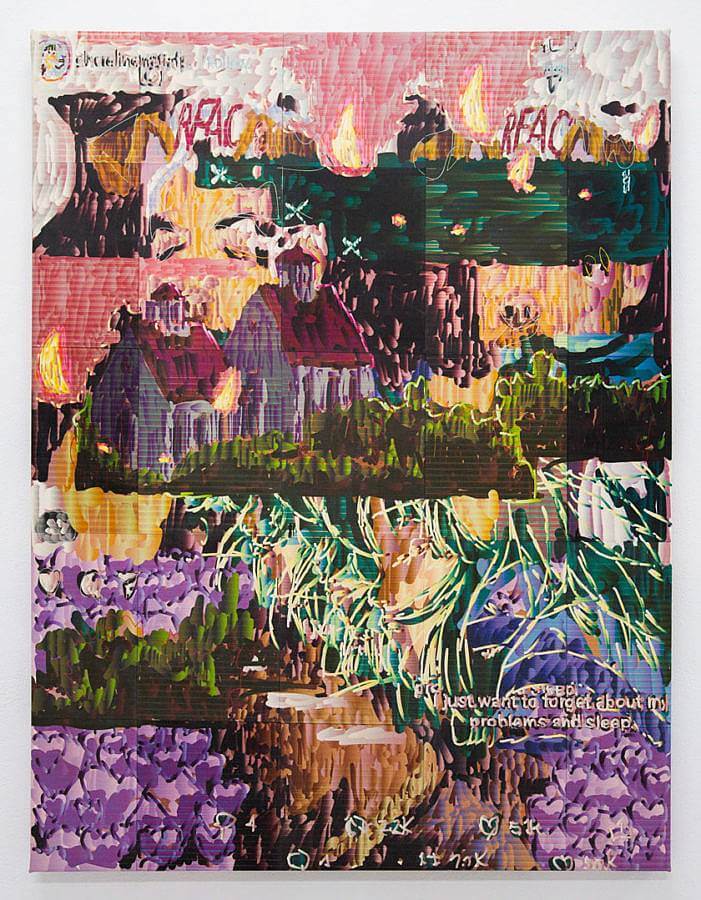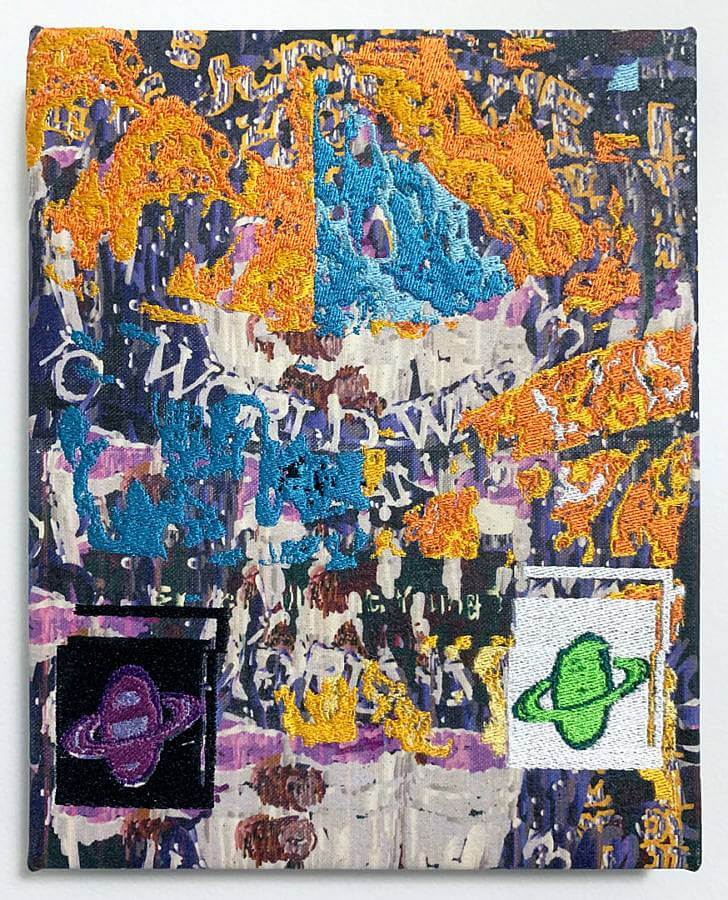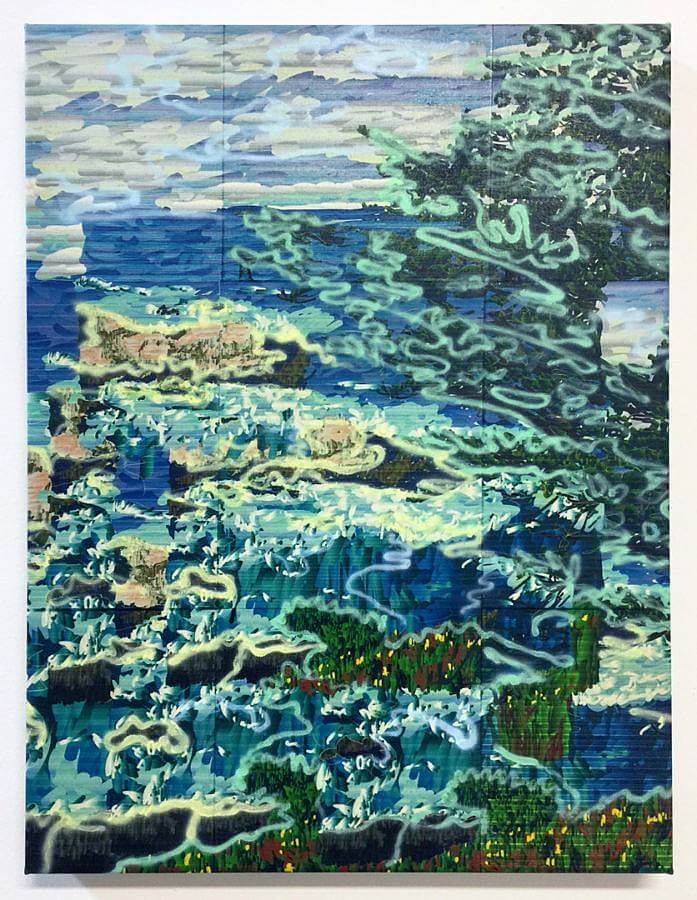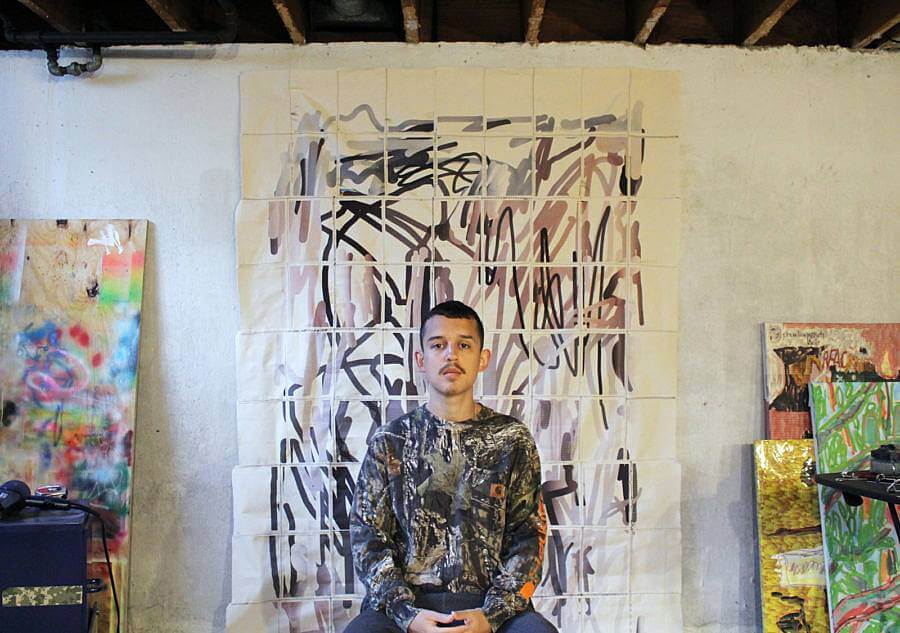
Tell us a little bit about yourself and how your interest in art began.
I was born and raised in the suburbs of Detroit. My dad met my mom as a Fulbright Scholar in Nicaragua in the 80s. He was a librarian, poet, and collected a lot of bootleg concerts on CD. My mom worked at the Universidad Centroamericana in Nicaragua and lived through an earthquake and political revolution before moving to the States with my dad. I feel like I inherited a lot of my creativity from my dad, but my mom really shaped my worldview.
I can trace a lot of my practice now to what I did as a kid. My dad got me a pirated copy of the Adobe suite and I would mess around in Photoshop trying to create cool shit by following online tutorials. This was during a very DIY era on the internet where people were using Photoshop to create cool “sigs” for online forums, WinAmp Skins, and MySpace profiles. I also watched a lot of Flash cartoons (RIP) and played a lot of online games. I would try to create my own animations and games in Flash as a result.
Nowadays, I’m doing the same thing. I create digital paintings based on a running image archive from social media and experiment by creating web applications that are somewhere between a moving image and an interactive object.
What is your current studio like?
Right now I’m working out of my home studio, which I’ve split into two workspaces. In my office, I do most of my digital work, printing, and sewing. In my basement I do the messier analog stuff, painting, using my airbrush, etc. I miss sharing a studio space with other artists, but I get a lot more work done here.
In my office, I tend to work in series and will start by printing out a digital painting on 8.5” x 11” paper and putting it up on a wall to evaluate it. Sometimes I’ll live with a work in this way for months before committing to creating it IRL.

Your pieces have a reverberating quality to them. Does this reflect your interpretation of the world?
The internet is ever-changing and ever-moving. It’s like a river in that it’s in a state of constant flow and will never repeat itself. That massive amount of information being communicated is inconceivable to us as humans, so this motion, this noise, is really what I’m trying to reflect in my work.
Aesthetically, I’m trying to emulate the sensation of the mind being overloaded with information. When it comes to landscape, I’m often trying to portray the passage of time seen in a video clip in a still image. In other works, like Sleep, I’m combining a lot of disparate images sourced from social media to simulate a sort of mental “afterimage” that results from scrolling through a social media feed. I’m trying to visualize the jumbled mess of half-finished thoughts that linger throughout the day.
Where else can you find images that evoke pleasure, pain, fear, jealousy, humor, and sadness all in the same viewing?

Sleep, Iron-on transfer on canvas, 46” x 35”, 2019
Can you describe the multi-layering process you use in your work?
Most of my figurative works start as a lo-fi collage made from different images I screenshot from social media. A lot of times, these images come from my feed and are algorithmically sorted “for me.” So I tend to look at the body of work as a running self-portrait.
After I create a collage, I’ll start drawing over the image in Illustrator using simple round brush strokes. I use a refined color palette based on the original 256 “web-safe” colors and make every stroke a gradient between two colors. This is what creates that “multi-layered” effect because the gradient allows you to see the overlapping of each stroke.
Can you discuss your use of embroidery in your practice?
I’ve started looking at canvas more like a textile than a surface for paint. It has its history in painting, but as I’m making these works I’ve started to relate to them much more like clothing, upholstery, and furniture. The textiles that you live with every day. I began using embroidery because my iron-on pieces started to feel very flat. I wanted a way to add texture and relief to the work without adding paint. I pull details out of the work that feel important or feel like they need to be in the foreground.
I have a Brother SE625 computerized embroidery machine with a 4” x 4” stitch area. So I tile the embroidered areas if the desired image is bigger than that. The embroidery takes a long time, sometimes 45 minutes per thread color, which I have to swap out manually. So a 4” x 4” square could end up taking 4 hours if it’s densely stitched or has a lot of different colors.
My favorite part about embroidery is its vibrancy. Thread reflects light much more dynamically than a printed surface. The finished embroidery shines differently depending on which angle you’re viewing it at.
How do you decide when to use digital media tools or analog techniques to create?
I started making paintings where I would mock up a lot of stuff on the computer and then cut stencils out of mylar and airbrush them onto canvas. But after a while, painting felt less like a creative act and more like a fabrication method, because it was all planned out beforehand.
I realized the idea of “hand” was very important to me, but that it didn’t matter whether the human gesture was being captured on the computer or IRL in a brushstroke. So now I predominantly work on the computer with a Wacom tablet to draw, but I make machines fabricate the work for me. It’s also important that I run the machines myself (like my printer, my embroidery machine) and don’t outsource it. I feel like this preserves my relationship with the work.
There’s a constant bouncing back and forth in my process. Often the source imagery will originate online, but I’ll redraw the image by hand. Then, I’ll print the image on canvas, but I’ll have to sew or iron things on by hand or maybe add a layer of paint on top. It’s important to me to work in a digital-analog loop, and that human touch is brought in at every step.

WWIII, Iron-on transfer and embroidery on canvas, 10” x 8”, 2019
As a result of the pandemic, many of us are viewing art through our screens at an increased rate. Has the rise in digital consumption of art impacted your practice?
Not really. What’s funny is I had a pretty dramatic shift in my work shortly before the pandemic hit the US. At the end of 2019, I got a little bored making digital paintings and a little mad at Adobe for making its software shittier. I started coding a drawing app that I could use on my phone, with the goal of making it easier to create work without being tied to a computer.
This coincided with me creating other interactive works that relied on human touch. I created these works with the idea that they could be projected at a monumental scale and that viewers of the work could manipulate it by visiting a website on their phone.
In your piece, “Biotech,” March 2020 you created a site that provides a real-time connection between people, allowing them to see the interactions of others synchronously. How does this work refer to how we communicate and connect in the digital age?
I wanted to create a website that connects people for the sake of connection, not for a profit incentive. I’ve been fascinated by the power of real-time connections online, whether that’s gaming, video calling, live streaming, whatever. There’s something so compelling about knowing that there’s a person on the other end reacting to your presence in real-time.
To that end, when I show the work now, it’s often in a one-to-one setting. I can interact with the piece and the person on the other end sees the effect of my touch on the composition. And vice versa. The common thread in my work is human touch, whether that’s a real-world object or an interactive work. I’m still investigating this concept of real-time connections because I feel like that’s one of the ways technology is working for us rather than against us.
3 favorite websites?
I’m a big fan of outwardly ugly looking websites that are relics from when I was a kid browsing the internet. It’s funny to look back on these things now and imagine the culture around them.
https://www.erowid.org/
Erowid’s homepage is permanently etched into my mind. Each time you visit, it gives you a random assortment of images of drugs ranging from Echinacea to LSD to Heroin. The website is a database of drugs and their effects on people, but it’s more famous for its first-person accounts of psychedelic experiences. It’s this weird, somewhat dark corner of the internet that captures a lot of the rebellious nature of the early web. I look at it as a predecessor to stuff like Silk Road.
https://www.14ers.com/
14ers is still very much alive and an active resource for mountain climbers. Back when I worked an office job, I would log on here daily and fantasize about traveling cross-country and scaling 14,000’ peaks. Reading the trail guides makes you feel like you’ve been there before, the language and images provide their own unique kind of escapism.
https://visibone.com/
A fine example of ugly early web design (how many sites do you visit today with a primarily dark brown color scheme??) What’s so unique and charming about this site is Bob Stein’s voice that’s present throughout. He made these “cheat sheets” to help web developers remember hex codes, coding syntax. etc. I kinda wish you could still buy them.

2017-02-15 11.06.59 (Big Sur), Iron-on transfer and airbrushed acrylic on canvas, 25″ x 19″, 2019
Can you discuss your upcoming solo show “Afterimage” with Playground Detroit and any other upcoming projects you have coming up?
An “afterimage” is the phenomenon of seeing a residual image after being exposed to particularly bright or bold stimuli. I’m interested in the concept of an afterimage when thinking about our relationship with online media. When our minds are at rest after everything we’ve seen, read, or heard in a day, what is left over?
The show will be a mix of figurative and abstract works that I’ve been making in my drawing app. I’m also hoping to install a large-scale interactive projected work as well. The show is slated for May 2021 and will be the outcome of my 20/20 Emerging Artists Fellowship with Playground Detroit, which I’m super grateful to be a part of.
I’m also actively trying to build up a newsletter for art-related stuff. I’m hoping to make it a community-centric thing where I can write studio updates and people can reply/discuss things going on in the art sphere. Email’s an old technology, but I’ve been seeing a lot of writers get traction with stuff like TinyLetter and Substack, so I’m hoping to do the same with art.
Other than that, I’ll be continuing to post new work to my site. Eventually, I’m trying to move away from Instagram and lean into the newsletter/website format for studio updates. But if you want to follow or message me on there as @frank.gl.
Interview composed by Amanda Roach.
